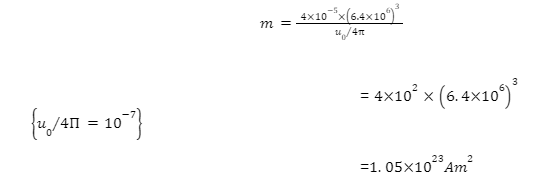On the surface of the earth, the strength of the earth’s magnetic field varies from place to place, in the order of 10–5 T. The magnetic field arises due to the electrical currents produced by the radiative motion of metallic fluids (consisting mostly of molten, iron, and nickel) in the earth’s outer core. This concept is used as a dynamo effect.
Earth’s magnetic field and dipole moment
• The magnetic lines of force of the earth are similar to the lines of magnetic force of the magnetic dipole at the centre of the earth.
• The poles close to the geographic north pole of the Earth are called the magnetic north pole. And the pole near the geographic south pole is called the magnetic south pole.
• By observing the earth’s magnetic poles we can see that the field lines of the magnetic poles (Nm) enter and exit the earth, unlike the case of magnetic bars. Magnetic pole (sm). This is because magnetic north was the direction indicated by the north pole of the magnetic needle. The north pole of the magnet was so named because it was the north pole. The south pole behaves like the north pole of a magnetic field inside the earth and vice versa.
• Earth’s magnetic field is also knowns as the geomagnetic field.
Example:
At the equator, the earth’s magnetic field is approximate to 0.4 G. Estimate the earth’s dipole moment.
Solution:
the equatorial magnetic field is
BE=u0m/4Π3
We have given that BE ~ 0.4 G = 4 × 10–5 T.
For the value of r, we take the radius of the earth 6.4 × 106 m. Hence,

The above value is nearly equal to the value 8 × 1022 A m2 quoted in geomagnetic texts.
Geographic and magnetic meridian
Consider a point on the earth’s surface, where the direction of the longitude circle determines the geographic north-south direction. The line of longitude towards the north pole is the direction of true north.
The geographic meridian is explained as a vertical plane made up of a longitude circle and the Earth’s axis of rotation.
The magnetic meridian of a location is the vertical plane that passes through the imaginary line connecting the magnetic north and south poles.
Angle of dip or inclination
When the magnetic needle is perfectly balanced around the horizontal axis so that it can swing in the plane of the magnetic meridian, the needle will be angled with the horizontal axis. And this angle is called the angle of dip or inclination.
Inclination or dip is the angle that the total magnetic field BE of the earth makes with the surface of the earth.
Example: The Inclination or the angles of dip at the poles and the equator, respectively, are:
At poles BH=0
angle of dip at pole ϕ= 90o
At magnetic equator BV=0
Hence, angle of dip which is given by
tanϕ=BV/BH=0
ϕ=0
Magnetic declination
Magnetic declination is the angle between the true geographic north and the north shown by a compass needle.
The magnetic declination is greater at the higher latitudes and smaller near the equator.
The horizontal component of earth’s magnetic field
BH=(kR/2NA)θ1
Where,
BH =the horizontal component of earth’s magnetic field
K = constant of the galvanometer
R = resistance of the circuit
N= number of turns of the coil
A= area of cross-section of the coil
θ1 – deflection in the galvanometer
The vertical component of earth’s magnetic field
Bv=(kR/2NA)θ2
here BV = vertical component of earth’s magnetic field
K = constant of the galvanometer
R = resistance of the circuit
N= number of turns of the coil
A= area of cross-section of the coil
θ2 – deflection in the galvanometer
The magnetic field at a point on the Earth’s surface can be described by three quantities., viz.,the horizontal component of the earth’s field BH, the declination D,and the angle of dip or the inclination I . These three components are known as the element of the earth’s magnetic field. Representing the vertical component by BV, we have
Bv=BEsin I
BH=BEcos I
Which gives
tan I =Bv/BH
Conclusion
The Earth’s magnetic field resembles a magnetic dipole in the centre of the Earth. The pole closest to the Earth’s geographical North Pole is called the North Pole. The pole closest to the South Pole is called the South Pole.
The dipole forms a small angle with the Earth’s axis of rotation and is aligned with it. And the magnitude of the field on the earth’s surface ≈ 4 × 10–5 T.
Mainly three quantities are needed to specify the magnetic field of the earth on its surface – the horizontal component, the magnetic declination, and the magnetic dip. These three quantities are known as the elements of the earth’s magnetic field.
 Profile
Profile Settings
Settings Refer your friends
Refer your friends Sign out
Sign out








